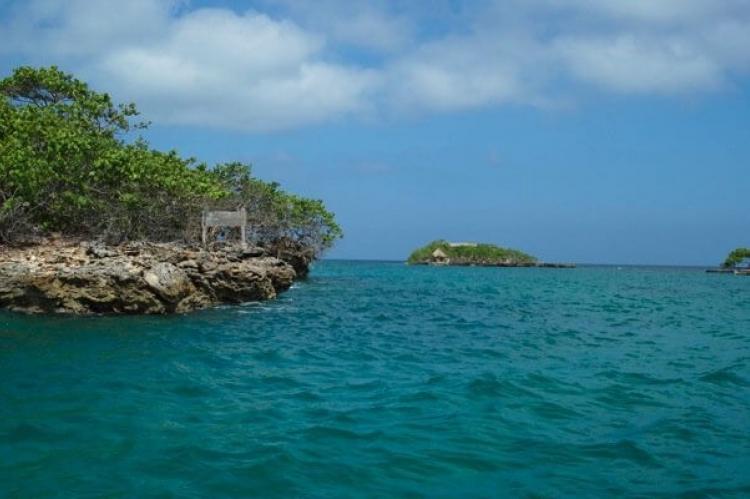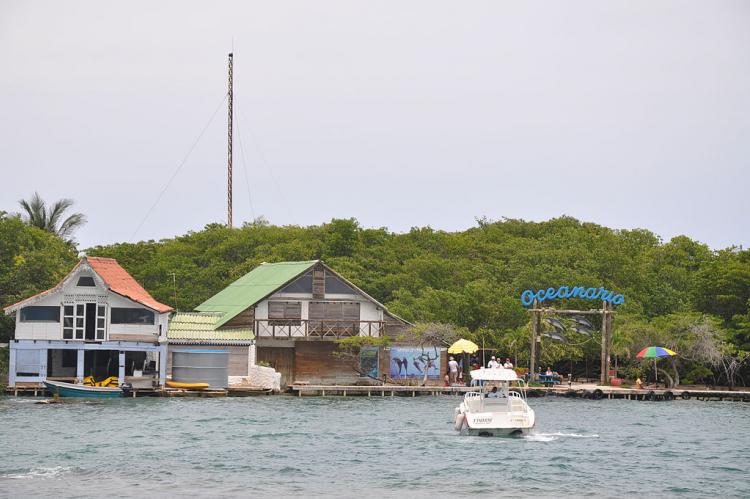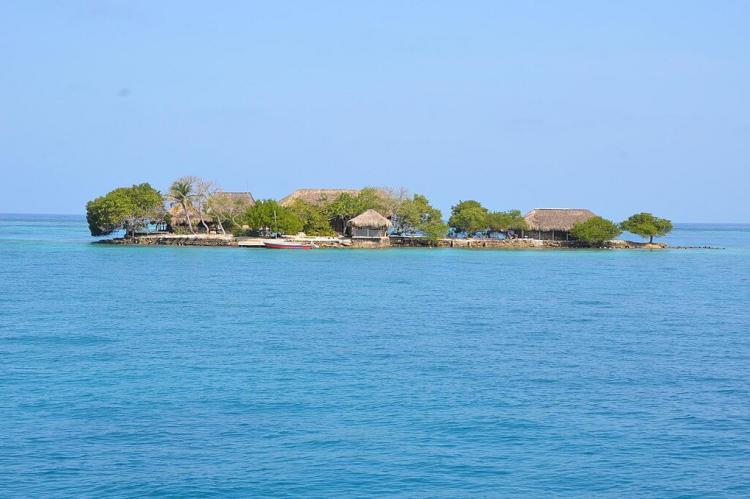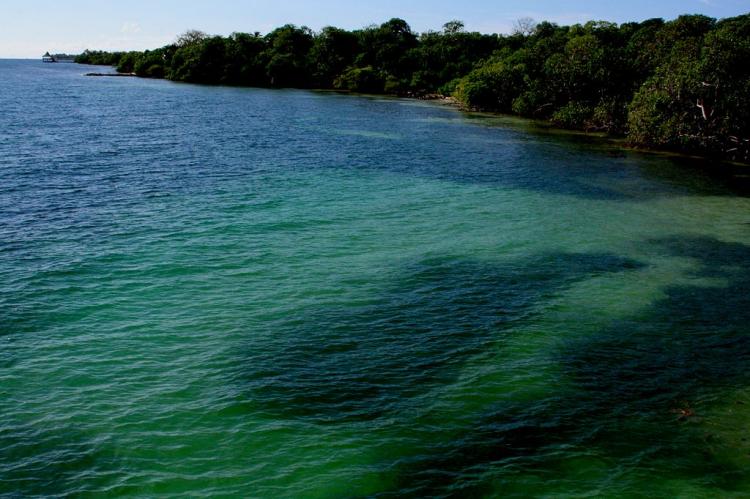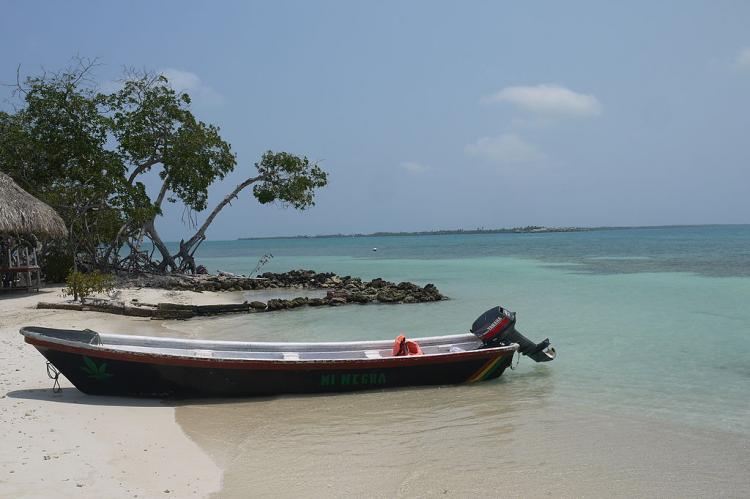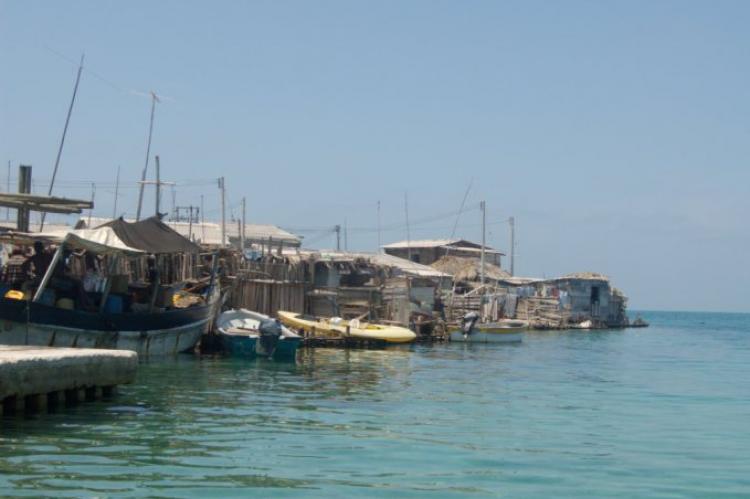Rosario and San Bernardo Islands: Rosario and San Bernardo Corals National Natural Park (Colombia)
Formed by the most extensive and diverse coral reefs in the Colombian Caribbean continental coastline, the Rosario and San Bernardo archipelagos are protected by the Rosario and San Bernardo Corals National Natural Park.
Rosario Islands
The Rosario Islands (Islas del Rosario) is an archipelago of about 28 small islands located off the Atlantic coast of Colombia in the Caribbean Sea. They comprise a mostly-underwater platform composed of successive coral formations at various depths.
Situated approximately 100 km (62 mi) from Cartagena, the Rosario Islands are administered by Colombia's Bolivar Department. Geographically, the archipelago is part of the Caribbean Region of Colombia and is one of Colombia's 46 Natural National Parks.
Although some islands are rocky or surrounded by mangroves, many exhibit pristine, white sand beaches, sparkling blue waters, and palm trees. They are popular as tourist destinations and for day trips from the mainland.
The Rosario Islands include the following islands:
- Big Island
- Marina Island
- Roberto Island
- Treasure Island
- Caribarú Island
- Arena Island
- Rosario Island
- Pirate island
- Fiesta Island
- Cagua Island
- Macaví Island
- San Quintin Island
- Pavitos Island
- El Peñón Island
- Majayura Island
- Maria del Mar Island
- Pajarales Island
- San Martin Island
- Gigi Island
- Coral Island
- Isla Pescadito
- Tijereto Island
- Pink island
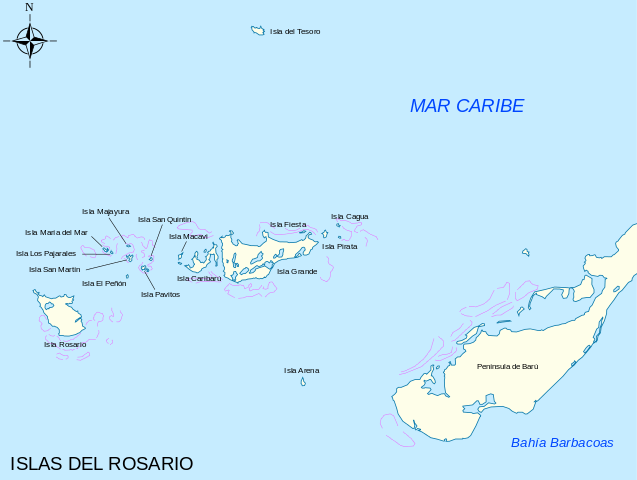
Map depicting the Rosario Islands
San Bernardo Archipelago
The San Bernardo Archipelago (Archipiélago de San Bernardo, Islas de San Bernardo) is a group of 10 coastal islands in the Gulf of Morrosquillo within the Caribbean Sea. Their approximate area is 213 sq km (82 sq mi). Administratively, the archipelago belongs to the Bolivar Department.
There are ten islands in the San Bernardo archipelago, but the three that receive the most tourism are Mucura, Santa Cruz and Tintipan.
The archipelago consists of the following islands:
- Boquerón Island
- Palma Island
- Panda Island
- Mangle Island
- Ceycén Island
- Cabruna Island
- Tintipán Island
- Maravilla Island
- Múcura Island
Santa Cruz del Islote
Also included is the artificial islet of Santa Cruz del Islote. Since 1996, part of the archipelago has belonged to the Corales del Rosario and San Bernardo Islands National Natural Park.
Santa Cruz del Islote (Santa Cruz Islet or Holy Cross Islet) is an artificial island. Compared with its small size, its significant population (approximately 1,200) makes it one of Earth's most densely populated islands.
The islet was started by locals who used materials such as coral, debris or stones to gain land from the sea in a part of the coast of low tide. It is believed that this first establishment dates from 1870. Due to its small size, some locals would later migrate to neighboring islets such as Tintipán Island or Mucura Island.
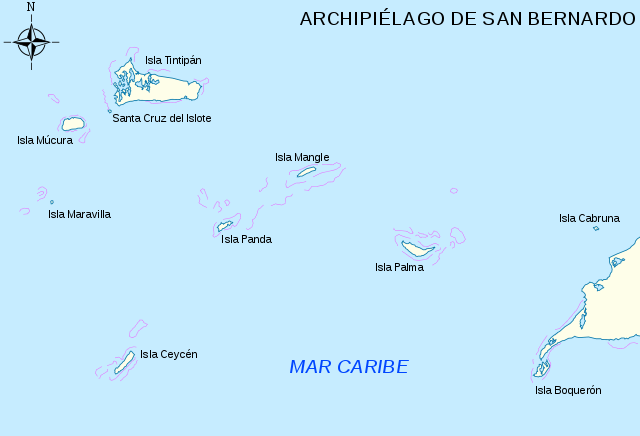
Map depicting the San Bernardo Archipelago
Rosario and San Bernardo Corals National Natural Park
Rosario and San Bernardo Corals National Natural Park is located in the Caribbean Region of Colombia. Its surface area is part of the Bolívar Department, except Boquerón Island, which belongs to the Sucre Department.
The park was founded in 1988 to protect one of the most important coral reefs on the Colombian Caribbean coast. It contains the most extensive, diverse, and developed coral reef on the Colombian Caribbean continental coastline.
The park has an area of 120,000 sq km (46,300 sq mi), from the highest tide line to the beryl of the 50 m (164 ft) depth. It extends from the underwater platform and the coral reefs west of the Island of Baru, the reefs of the archipelagos of Nuestra Señora del Rosario and San Bernardo and the submerged platform in between, as well as the Tesoro, Rosario, Mucura and Maravilla islands.
This area was declared a Natural National Park due to the necessity to preserve and protect the coral reefs and the associated ecosystems, such as the seagrass and mangroves, as well as the numerous species of seaweed and animals that inhabit them.
The protected area includes four islands that are designated as untouchable zones. Two are in Our Lady of Rosario Archipelago (Tesoro and Rosario Islands), and two are in the San Bernardo Archipelago (Maravilla and Mangle Islands).
Rosario and San Bernardo Corals National Natural Park constitutes an underwater set of ecosystems and communities inhabited mainly by corals home to hundreds of microscopic animals, fish, crustaceans, mollusks, anemones, urchins and starfish, as well as a wide range of seabirds.
